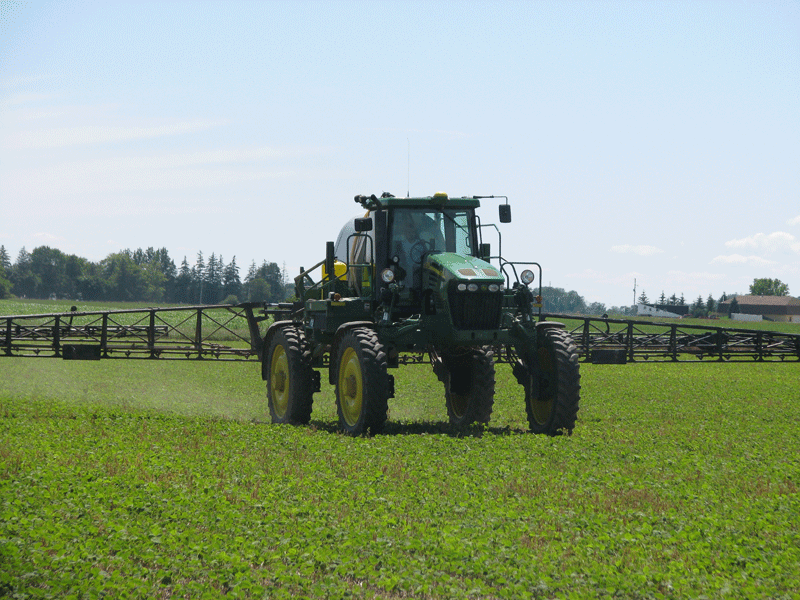Proper fungicide applications
CONSIDER THE RISKS
MINIMIZING YIELD LOSSES due to disease begins with understanding the potential risk factors for disease development in your field. The three main factors for disease development are host, pathogen, and environment.

“You want to take into consideration the various different factors that can influence disease levels, and a lot of these are pre-planting risk factors that we can influence in many ways,” says Albert Tenuta, Pathologist, Field Crops Program Lead with the Ontario Ministry of Agriculture and Food and Ministry of Rural Affairs (OMAF and MRA). “Whether it’s hybrid susceptibility, planting date, or corn residue, all of those things have an influence on either the host or the pathogen.”
According to Tenuta, there are seven diseases to watch out for in 2014. In corn, growers will want to keep an eye out for anthracnose leaf blight, eyespot, Northern leaf blight and grey leaf spot. In soybeans, he says soybean cyst nematode, white mould, and frog-eye leaf spot could be particularly bothersome this year. Knowing the disease risk factors, and how to manage for disease if and when it happens, is key to keeping losses at a minimum.
Knowing your fields and their history of disease is also important, says Tenuta. Because many diseases survive on residue left in the field, he suggests removing that residue to lower the risk of disease.
The environment itself also plays an important role in disease development. Most diseases prefer wet and humid conditions, so paying close attention to environmental conditions and knowing which diseases prefer what conditions can go a long way in preventing loss due to disease.
FUNGICIDE APPLICATIONS: FACTORS TO CONSIDER
With most crops, the decision to use a fungicide is based on whether or not a disease is present. Unfortunately, there is not one sweeping solution that works for all crops. Producers should make decisions specific to both the disease present and the crop it is present in. According to research trials, fungicide applications are most effective in the presence of disease or when the immediate threat of disease is present. While application timings are based on thresholds in some cases, thresholds do not exist for every crop-disease combination. If you are not sure, always ask your local expert.
Typically, foliar fungicides have two to three weeks of activity, making it all the more important to apply it at exactly the right growth stage. Depending on the disease, applications should be made at, or prior to, the onset of disease. In some cases, this window of opportunity is very small.
When it comes to timing, the environment is an important consideration. For instance, if it is too hot, or the humidity is below 50 percent, the application could evaporate before even reaching the surface of the plants. In windy conditions, the application could be lost to spray drift. Also, remember that when applying a fungicide, foliage needs to be dry or the product could be diluted or run off the plant’s surface. Similarly, applications can be lost to rainy conditions, another reason why timing your application is extremely important.
One of the big considerations for producers is whether or not an application is economically viable. Things to consider when making this decision include the level of disease pressure, labour and fuel costs, the cost of the application itself, and the potential yield losses due to disease. With northern leaf blight in corn, if the leaves above or below the ear leaf start seeing disease at tassling, Tenuta says a fungicide application is probably warranted.
SPRAYER CONSIDERATIONS
“With a fungicide, no sprayer setting is going to save you if you get there too late,” says Jason Deveau, Application Technology Specialist with OMAF and MRA. “Honestly, we can nitpick droplet size and boom height, but if you miss that window, it doesn’t matter.”
When it comes to spray nozzles, a lot of growers are starting to look at twin fans, particularly for wheat, says Deveau. “The reason they’re doing that is because a twin fan will give you coverage coming and going. One side of the fan is aimed into the direction that the sprayer is moving, and the other side sort of shoots backwards, trailing behind.”
There are at least a dozen varieties of twin fans available. Some are asymmetrical, while others work with angles. Deveau says he has seen twin fans succeed and fail.
“One of the reasons they fail is because growers drive too quickly,” he says. “And what happens is that it bends the fan in front straight down, and makes the spray coming out the back come straight out. In order for these fans to work the way they’re designed, you’ve got to slow down.”
It is important to note that all nozzles perform differently under different conditions. With that said, there is no one perfect nozzle for the job; rather, there is a perfect nozzle for the given conditions.
Depending on the nozzle you have chosen, Deveau says the boom height should be set anywhere between 35 and 50 cenitmetres above the target. Be sure to read the package closely. It should tell you the recommended height for that particular nozzle. The reason you want to make sure the boom height is correct is because this makes all the difference when it comes to creating the perfect spray. Too close – and you will hit the crop with spray that is too heavy. Too far away – and the spray will drift off before actually touching the crop.
The best advice Deveau has to offer is to buy a package of water sensitive paper. “Because all of these variables wreak havoc with anything I’m saying, what works for one guy may suddenly not work for another. It just depends on the variables that day.”
“The ultimate way to know where your sprayer is going is to have some feedback,” he continues. Water sensitive paper starts out bright yellow, but turns royal blue wherever water hits it. If you want to make sure your spray is going where you want it to go, simply pin or staple a piece to the area in question. If it is blue when you’re done spraying, you know you’ve hit your target.
“If it’s still canary yellow, then your spray didn’t go where it was supposed to go and you need to reconsider how you’re balancing all of these variables,” Deveau says.
Water volume could be the issue. “More water means more drops and more drops means better odds of covering your target. Upping your water volume, dropping your boom a little bit, watching your speed, and using the feedback from these cards – that combination can improve coverage. And, of course, all that goes out the window if you’re spraying a day late.” •







